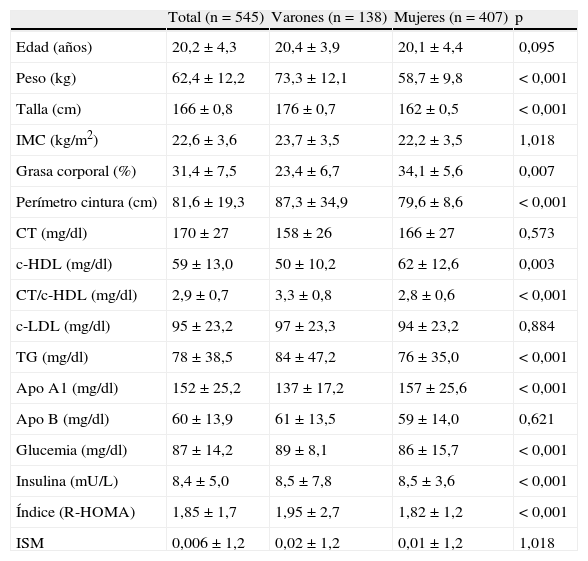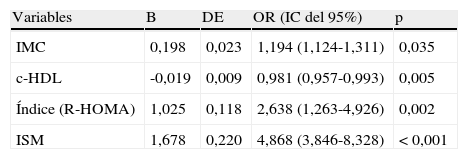La prehipertensión es una nueva categoría de presión arterial, y se considera un factor de riesgo vascular. Hemos estimado la prevalencia de prehipertensión y la asociación entre esta condición y otros factores de riesgo vascular en adultos jóvenes.
Sujetos y métodosInvitamos a participar a los universitarios del primer curso de todas las titulaciones que se imparten en el Campus Universitario de Cuenca. Se consideró prehipertensión a una presión arterial sistólica de 120-139mmHg y/o presión arterial diastólica de 80-89mmHg. Se midieron las variables antropométricas, lipídicas y metabólicas. Se valoró la presencia del síndrome metabólico, y se cuantificó en función de la suma de las puntuaciones estandarizadas del perímetro de cintura, la razón triglicéridos/c-HDL, presión arterial media y R-HOMA (índice de resistencia a la acción hipoglucemiante de la insulina).
ResultadosSe incluyeron en el análisis 545 universitarios (edad media [±DE] 20,4±3,9 años; 74,7% mujeres). La prevalencia global de prehipertensión fue del 24% (IC del 95%: 21-27%), (varones: 56,5%; mujeres: 13,0%). La condición de prehipertensión se asoció de forma directa al índice de masa corporal (OR: 1,194; IC del 95%: 1,124-1,311), resistencia al efecto hipoglucemiante de la insulina (R-HOMA, OR: 2,638; IC del 95%: 1,263-4,926) y al índice o cuantificación de la severidad del síndrome metabólico (OR: 4,868; IC del 95%: 3,846-8,328). Por el contrario, la prehipertensión se asoció de forma inversa con la concentración de c-HDL (OR: 0,981; IC del 95%: 0,957-0,993).
ConclusionesUno de cada 4 adultos jóvenes presenta prehipertensión. Esta condición se asocia a los factores de riesgo vasculares bien establecidos.
Prehypertension is a new category of blood pressure and is considered a cardiovascular risk factor. This study has aimed to estimate the prevalence of prehypertension and the association between prehypertension and other vascular risk factors in young adults.
Material and methodsFirst year university students from all areas of study in the University of Cuenca were invited to participate. Prehypertension was defined as systolic blood pressure between 120-139mmHg and/or diastolic blood pressure between 80-89mmHg. Anthropometric, lipid and metabolic variables were measures. The presence of metabolic syndrome was evaluated and quantified based on the sum of the standardized scores of the waist circumference, the triglyceride/c-HDL ratio, mean blood pressure and R-HOMA (Index of insulin resistance to glucose lowering effect).
ResultsA total of 545 university students were included in the analysis (mean age 20.36±3.9 years, 74.7% women). Prehypertension prevalence was 24% (95% CI: 21-27%), (56.5% in men and 13% in women). The condition of prehypertension was directly associated to the body mass index (OR:1.194; 95% CI:1.124-1.311), insulin resistance (R-HOMA, OR:2.638; 95% CI:1.263-4.926) and to the index or quantification of the severity of the metabolic syndrome (OR:4-868; 95% CI:3-846-8-328). On the other hand, HDL-c showed an inverse relationship with prehypertension (OR:0.981; 95% CI:0.957-0.993).
ConclusionsOne out of every four young adults presents prehypertension. This condition is associated to well-established vascular risk factors
Article
Diríjase desde aquí a la web de la >>>FESEMI<<< e inicie sesión mediante el formulario que se encuentra en la barra superior, pulsando sobre el candado.

Una vez autentificado, en la misma web de FESEMI, en el menú superior, elija la opción deseada.

>>>FESEMI<<<







